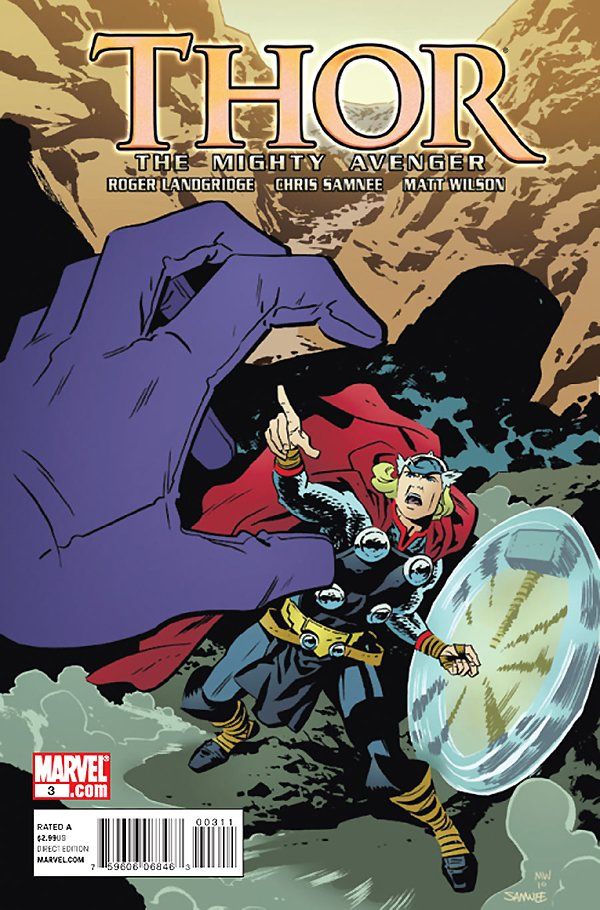On the heels of Marvel's cancellation of the all-ages Thor: The Mighty Avenger, iFanboy's Jason Wood asks Can the Direct Market Save All Ages Material?
Wood starts off with a little analysis, pointing out that although TMA was well loved by some vocal fans, it didn't sell well, and in fact, all-ages material doesn't do well in the direct market. There is also the fact that Thor is not a particularly popular character, and there are a number of other Thor titles on the market. On the other hand, Wood feels that TMA was at least as high quality as the others, and better than some, so why didn't it sell? A commenter gets to the heart of the matter:
Consider too that Thor TMA is neither in 616 or Ultimates continuity. As much as some hate this fact, if it "counted", more traditional consumers would have bought it.
You know, I do hate that fact. There's an element of trying to squeeze a square peg into a round hole here. Most comics shops don't have a big kid audience, and despite Diamond's attempt to change that, the fact remains that most comic-shop customers aren't kids and most kids never go near a comics shop. The direct market does a good job of delivering a specific product to a narrowly defined audience. That audience is not very interested in all-ages comics, and children aren't interested in complicated continuity. This is a basic structural flaw: You have a huge potential market for these comics, but you are selling them in a place the target customer seldom goes to and may not even realize exists.
This is not to beat up on retailers. The simple fact is that many communities don't have a comics shop, and where they do exist, most people don't know they are even there. That right there is a huge limit on the potential audience. Add to that the fact that many shops won't carry the comic anyway, precisely because their audience is so tightly targeted (and because of nonreturnability). As Zack Kruse, marketing director for DCB Service/Instock Trades, says in the article,
The problem is what direct market participants KNOW they can sell often leaves things that CAN/WILL sell left behind—particularly if the shelves are already saturated with a particular character, company, event, or it’s a heavy month of ordering, or whatever. The quality of the book, or even the perceived quality of the book, is, as you know, in no way an indicator of how it will perform in the direct market.
Children's comics sell well in other venues. Wood and his commenters point to the success of Archie comics, but they do well precisely because they are not restricted to the direct market; Archie comics are in bookstores and at supermarket checkouts. Manga is another example; even at the height of the manga boom, most titles sold miserably in the direct market but went like hotcakes in bookstores (i.e., stores children actually go to). Scholastic sells a ton of graphic novels at their book fairs. There are direct market retailers who choose to make their stores welcoming to children and parents; Wood turns the floor over to one such retailer, Patrick Brower of Challengers Comics + Conversation, who has made it work:
So here’s my point… on December 8th when the Thor Mighty Avenger trade paperback comes out, we’ll rack it in our all-ages section and watch it sell 3 times what it would in the regular Marvel graphic novel section. All ages comics CAN exist and prosper in the direct market, but they have to be marketed to the customer as such. And by the retailer, NOT by the publisher.
But what Brower seems to be saying is exactly the point made above: He will sell Thor: The Mighty Avenger to children and their parents, not to the core comics-shop customers, the ones he has in common with all other comics shops. Truly kid-friendly comics stores are to be commended—I love them, myself—but their shoulders are not broad enough to support an entire line of comics.
Brower brings up another important point: Even in a comics shop, in the all ages category, graphic novels outsell single-issue comics. Again, there's a culture clash: The Wednesday crowd, pre-ordering from Previews, coming in regularly to get a small bite of a larger story, versus kids who aren't interested in going through a whole procedure to get their comics, and who like a lot of story in a single chunk. Spinner racks were great when every issue of Superman had three complete stories in it; they don't work for long story arcs, though, because it's too easy to miss an issue. That is the comics shops' strength. The logical thing with a comic like Thor would be to release it straight to trade, with an attractive trade dress (not those white-on-black spines that all look alike) and sell it in chain bookstores, comics shops, book fairs, and anywhere else that will take them. But comics marketing seems to all be geared in a single direction, toward the narrower path.
Ultimately, this is Marvel's loss. They have a Thor movie coming out next year, and some young people will love the story enough to seek out comics shops, where they will have a choice between some complicated, bloody story they can't understand (and their parents will snatch out of their hands anyway) or a few faded year-old issues and trades of a story that ends too soon. It doesn't have to be this way. The direct market can suport all-ages comics. It just can't do it alone.


